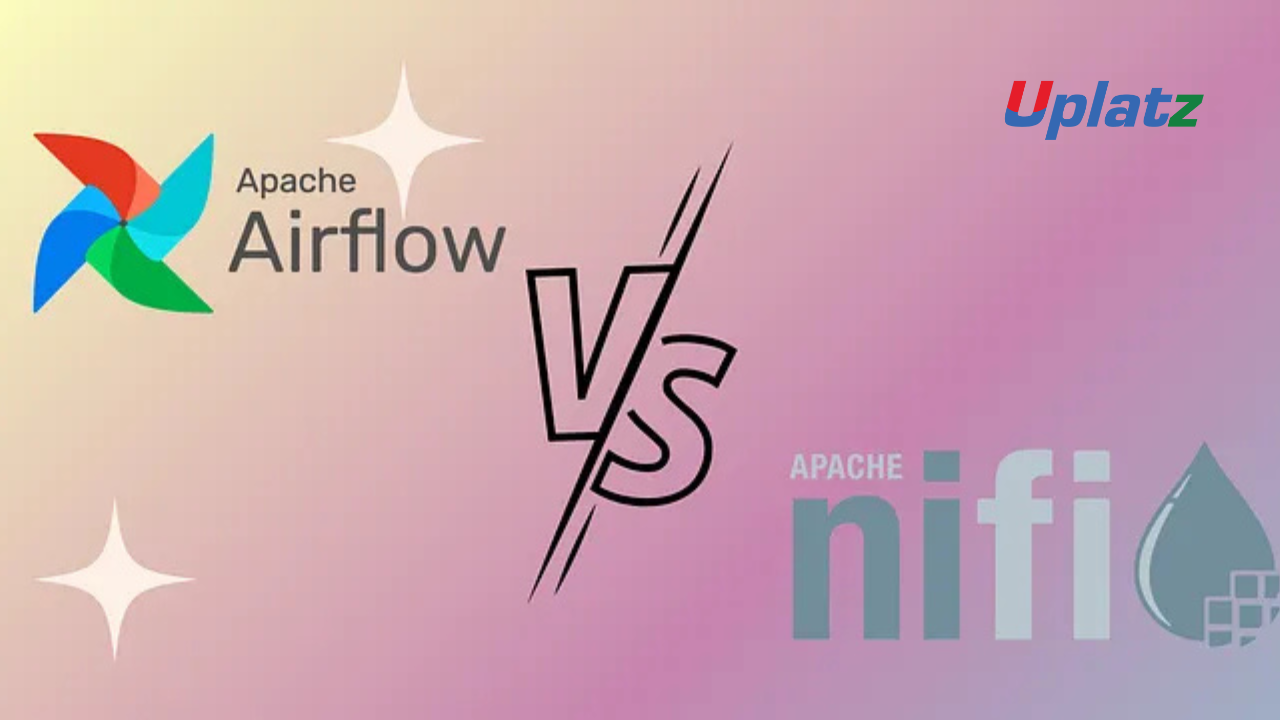Summary
This blog explores the core differences, architectural philosophies, and practical use cases for NiFi and Airflow, helping data teams determine which platform best aligns with their operational needs—or whether a hybrid approach offers the best of both worlds in real-time vs batch data orchestration.
As modern data ecosystems scale rapidly, organizations must decide between real-time and batch data orchestration architectures. Apache NiFi and Apache Airflow have emerged as two powerful, open-source tools built to address these distinct processing paradigms. This blog explores the core differences, architectural philosophies, and practical use cases for NiFi and Airflow, helping data teams determine which platform best aligns with their operational needs—or whether a hybrid approach offers the best of both worlds.
Apache Kafka Program By uplatz
Introduction
The exponential growth of data from sensors, applications, users, and systems has pushed enterprises to reevaluate how they ingest, process, and move data. Traditional batch processing systems are no longer sufficient on their own. Instead, organizations are adopting orchestration solutions that can handle both real-time streaming and complex batch workflows.
Apache NiFi and Apache Airflow are two leading data orchestration platforms. While both are under the Apache umbrella and serve the data pipeline space, they fundamentally differ in design, philosophy, and use cases.
While both are under the Apache umbrella and serve the data pipeline space, they fundamentally differ in design, philosophy, and use cases. This comparison of real-time vs batch data orchestration helps clarify where each tool shines and how they can be used together.
Understanding the Core Differences
Apache NiFi: Real-Time Dataflow Engine
Apache NiFi is built for streaming data ingestion, transformation, and routing. Originally developed by the NSA, NiFi introduces a visual, flow-based programming interface and excels in real-time scenarios where latency and data freshness are crucial.
Key features include:
-
Drag-and-drop UI for building data pipelines
-
Real-time, event-driven processing
-
Built-in back pressure management
-
Full data provenance and lineage tracking
-
Support for 300+ connectors across cloud, database, IoT, and messaging systems
Apache Airflow: Batch Workflow Orchestrator
Apache Airflow is designed for scheduled batch workflows. Built around Directed Acyclic Graphs (DAGs), Airflow is code-centric and highly programmable, making it the go-to platform for complex ETL jobs and analytics pipelines.
Key features include:
-
Python-based DAG definition
-
Sophisticated scheduling and dependency management
-
Native integration with 1,500+ tools and platforms
-
Flexible execution with Celery, Kubernetes, or local workers
-
Strong support for CI/CD and ML orchestration
Architectural Approaches
NiFi’s Architecture
NiFi operates within a JVM and is made up of modular components:
-
Flow Controller – manages execution threads
-
Web Server – provides the UI and REST API
-
Repositories – handle metadata, content, and provenance
-
ZooKeeper integration – enables clustering and fault tolerance
Its decentralized, zero-leader architecture is ideal for horizontally scaling real-time flows.
Airflow’s Architecture
Airflow consists of:
-
Scheduler – triggers tasks based on time or conditions
-
Web Server – UI for monitoring DAGs
-
Workers – run individual tasks
-
Metadata DB – stores job and state history
The architecture supports both development and production scaling across cloud-native environments.
Processing Paradigms: Real-Time vs. Batch
Real-Time Use Cases with NiFi
-
IoT sensor ingestion
-
Real-time log aggregation
-
Social media/event stream processing
-
Live data routing across cloud and on-prem
NiFi ensures low-latency processing with immediate feedback and strong control mechanisms.
Batch Workflows with Airflow
-
Daily/weekly ETL pipelines
-
Machine learning model training
-
Business reporting automation
-
Data warehouse synchronization
Airflow provides repeatable, programmable job orchestration that’s ideal for complex data pipelines and dependency chains.
User Experience and Usability
-
NiFi: Designed for non-developers and hybrid teams with its GUI-based interface. Minimal coding needed.
-
Airflow: Requires Python scripting and DevOps familiarity but offers high customization, scalability, and testability.
Scalability and Performance
-
NiFi: Supports edge processing (via MiNiFi), clustered deployment, and back pressure management.
-
Airflow: Scales through multiple execution models—Celery (distributed), Kubernetes (container-based), etc.
Integration and Ecosystem Support
-
NiFi: Best for real-time system integrations (Kafka, MQTT, HDFS, APIs)
-
Airflow: Best for enterprise-scale platform orchestration (AWS/GCP/Azure, Databricks, Snowflake, etc.)
Decision Framework: When to Use What
| Use Case | Choose NiFi | Choose Airflow |
|---|---|---|
| Real-time data ingestion | Yes | No |
| Batch ETL and analytics workflows | t Not ideal | Yes |
| Low-code visual design | Excellent | Requires coding |
| Scheduling and complex dependencies | Limited | Powerful |
| Scalable streaming infrastructure | Strong | Not designed for streaming |
| DevOps-centric environments | Limited CLI, mostly GUI | DevOps-native |
Conclusion
Apache NiFi and Apache Airflow are both best-in-class—but for very different scenarios. NiFi is your go-to for streaming and real-time flow, while Airflow is purpose-built for scheduled and batch-driven workflows.
However, many organizations successfully combine both tools. For instance, NiFi ingests and cleanses streaming data from IoT or APIs, while Airflow later picks up that data for transformation, modeling, or analytics.
In a world where data never sleeps, hybrid orchestration strategies offer both flexibility and control. Understanding how to leverage each tool’s strengths is key to building a future-ready real-time vs batch data orchestration architecture.
